On the Road – Distance 76km / 48 mi | Elevation 1715m / 5627ft
Please watch my Relive video here: https://www.relive.cc/view/vMq5eBJ8MQq


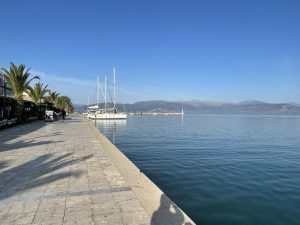

Our group pre-ride stretch
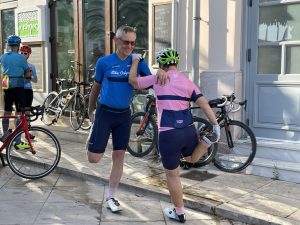
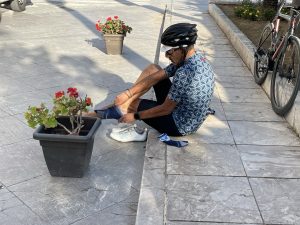
Hugging the coast out of Nafplion and leaving the brooding fort behind, we headed straight for the impressive site of Mycenae, while still cool and uncrowded. A gentle 500m climb off route, this was definitely worth a look around (see more below).
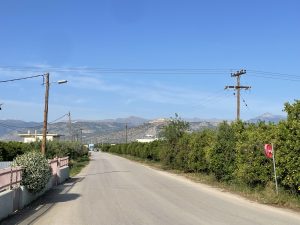
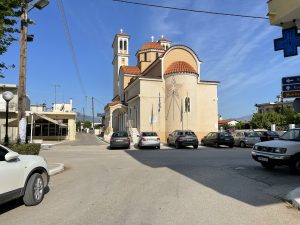
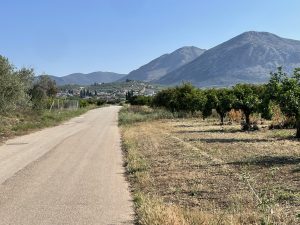

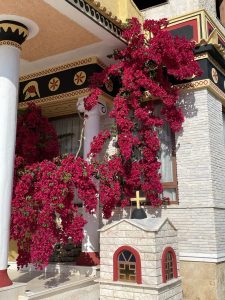
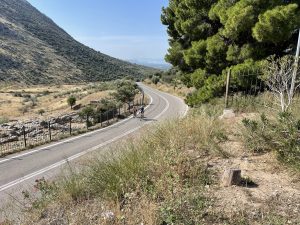
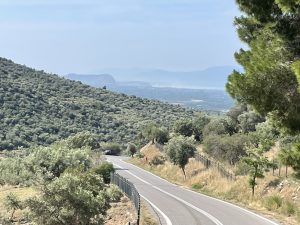
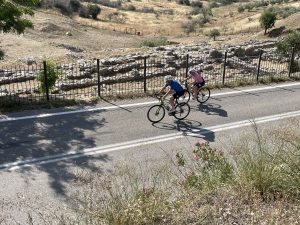
Rolling on to Nemea for lunch, where we had a great homemade Greek meal at a family run tavern…mousaka, sausage and cheeses, pulled lamb shank and potatoes…very filling but we still had a big climb to do!

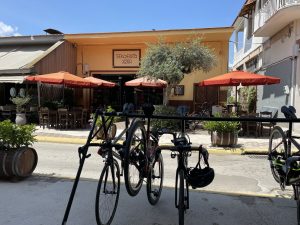

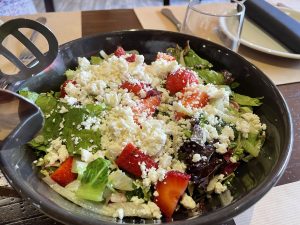
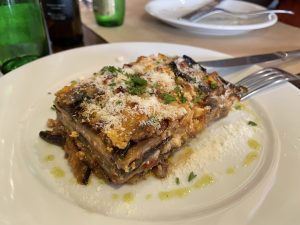
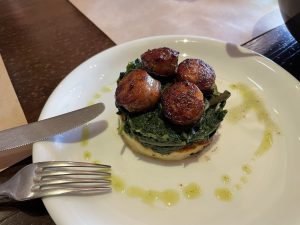

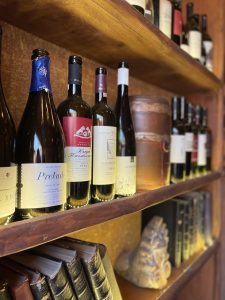
We then pedaled out into the Nemean wine region. Evident in wine making barrels frequently, and the hills are packed full of vineyards – and of course the odd olive tree!
 new stock planted left, vineyards as far as the eye can see!
new stock planted left, vineyards as far as the eye can see! 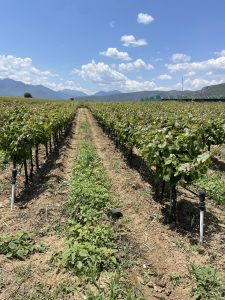
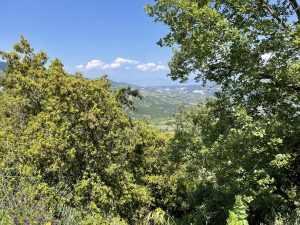
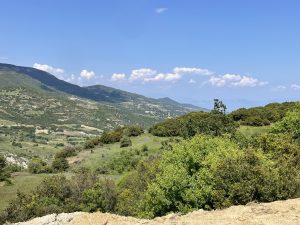
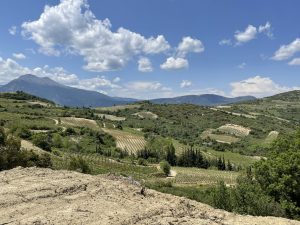
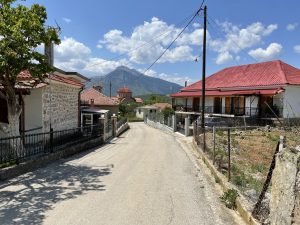

You can feel the fertility of this area, with grapes everywhere, olive trees, poppy fields and strawberries on the distant slopes too.
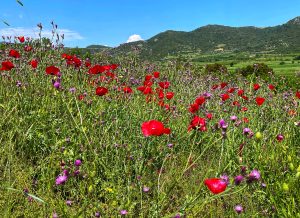
We headed straight toward a large flat topped mountain but skirted around it gently for a long while, then had a 14.9km climb, averaging 5%, then an awesome descent before at the very last – heading quite shockingly straight up! for 2km into the small ski village of Kefalari for the night.

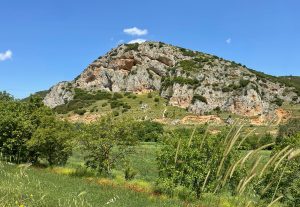

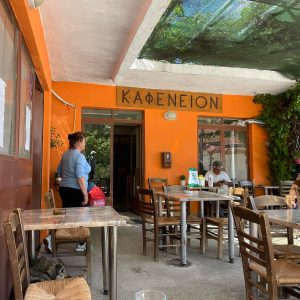
A quaint town with a beautiful small square, a couple of classic village lodges and a singular tavern to house and feed us for the night. Luckily, the tavern was a gorgeous family run affair with Sofia passionate about her food and made sure we had an excellent evening…it was a feast of spanakopita, mousaka, Greek salad, roasted chicken, stuffed peppers, eggplant and tomatoes, baklava and lots of wine.
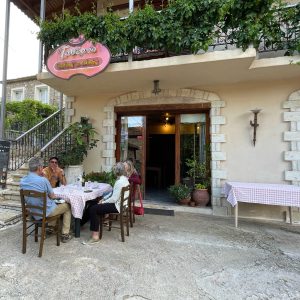
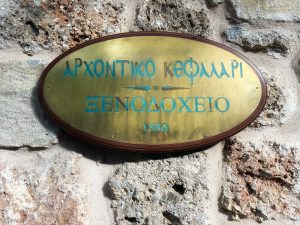

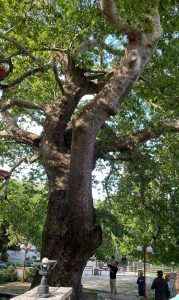


Life is good in Kefalari !
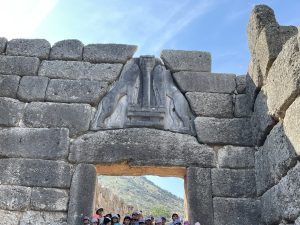
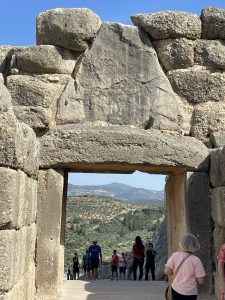
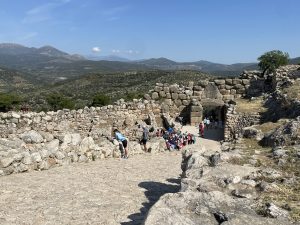 the Lion’s Gate
the Lion’s Gate
An imposing entrance beautifully preserved – we were immediately rewarded with a burial chamber made with incredibly well built circular slabs.



And the backdrop views are long and peaceful – you can completely understand why this spot was chosen.






This is the most interesting ruins here, but continuing up, the views are even better, a number of ruins, including the bath where Agamemnon was killed by his wife Clytamestra for sacrificing both of his daughters (Ipheginia and Kassandra) in hope of appeasing the gods.
Better-known as Hercules (the Latin version of his Greek name), Heracles was the all-round action hero of Greek mythology. He was ordered to carry out his famous ‘Twelve Labours’ as penance for the murder of his own wife and children, while he was in the service of King Eurystheus, Hercules’ cousin. A few of them are quite famous – Hercules killing the Nemean lion (where we ride today), or stealing the golden apples of the Hesperides – but others, such as slaying the Stymphalian birds, are more obscure.
Strangling the Nemean lion: The Nemean lion was a monster, the son of Orthrus and Echidna. It dwelt in the region known as Nemea, living in a cave and feeding on whatever it could find, causing havoc and terror throughout the land.
The lion’s cave had two entrances. After failing to kill the fearsome animal with his bow and arrow and his club, Hercules forced the lion back into its cave, blocked up the other exit, and then strangled it to death. He flayed the dead animal and wore its skin (with the animal’s head serving as a helmet).
Slaying the Lernaean Hydra: This monster was another of Echidna’s offspring, this time with Typhon. The Hydra – a snake with several heads (how many differs from telling to telling, from around five right up to a hundred) – had breath so foul that even that was enough to kill a man. This time, Hercules’ arrows were successful against the beast, especially when he set them on fire. He then chopped off the animal’s numerous heads.
Thankfully, Hercules was assisted by Iolaus, his nephew, which was just as well, since beheading the Lernaean Hydra was a bit like playing whack-a-mole: as soon as a head was lopped off, it immediately grew back. Together, the two of them used burning brands to seal up the various necks of the beast so new heads couldn’t pop out.
Capturing the Erymanthian Boar. This creature lived on the snow-capped Mount Erymanthus, and Hercules caught it by calling to it so it came out of its lair, and then leading it a merry dance among the snow until, exhausted, the animal collapsed and he was able to capture it and bring it alive to Mycenae.
Capturing the Hind of Ceryneia. Next, Hercules had to capture a large female deer that was ravaging the crops at Oenoe. This creature gave him the runaround, and it was only after tracking it across vast northern terrains for over a year that he could eventually wound it with an arrow and then capture it, taking it alive.
Killing the Stymphalian Birds. For this labour, Hercules faced a whole flock of these birds which lived in Arcadia and were munching away at the crops. Using bronze castanets, Hercules was able to shoo them out of the bushes and kill them with – you’ve guessed it – his arrows.
Cleaning out the Augean Stables. This is one of the more famous labours of Hercules. Eurystheus wanted to humiliate him by making him perform such drudgery. Augius owned substantial herds, but he didn’t bother to have the dung cleared out of the stables. Hercules completed this menial – and doubtless very smelly – task, but insisted on a wage for doing so.
Capturing the Cretan Bull. This creature also turns up in another famous myth, involving Theseus and the Minotaur. The Minotaur was a man with the head of a bull: the product of a rather twisted coupling between Pasiphaë, King Minos’ wife, and a ferocious bull that Poseidon had brought out of the sea so that Minos could sacrifice it to him. However, Minos was so taken by the bull that he sacrificed a different animal and hoped Poseidon wouldn’t notice. But Poseidon wasn’t fooled, and to punish Minos for his deceit he made the bull so savage that it was a menace to Minos, and Pasiphaë, Minos’ wife, desired the bull – lying with it and conceiving the famous Minotaur, a man with the head of a bull. Hercules travelled to Crete and Minos gave him his blessing in his quest to capture the bull. Hercules then took the bull to Hera, who freed it.
Stealing the Mares of Diomedes. Accounts vary for this labour, but the general plot sees Hercules having to bring the four mares belonging to Diomedes, the King of Thrace, alive to Eurystheus. But although Hercules managed to free the horses from the bronze mangers in which they were kept, bound fast with iron chains, in some versions Hercules fed Diomedes to his own horses, which devoured human flesh.
Capturing the Girdle of Queen Hippolyta. Eurystheus’ daughter Admete gave Hercules this challenge: capture the girdle worn by Hippolyta, the fearsome Amazon warrior. Hercules travelled to the land of the Amazons and persuaded Hippolyta to give him the girdle, but Hera sowed division between the two parties and Hercules ended up killing Hippolyta.
The Cattle of Geryon. This adventure could form the basis of an epic in itself. Tasked with travelling to the island of Erythia, where a man named Geryon owned a huge herd of cattle, Hercules had to cross the Libyan desert and, growing sick of the heat, threatened to shoot the sun, until Helios lent the hero his Cup of the Sun, which Hercules used to cross the ocean. But when the waves threatened to capsize the vessel, Hercules aimed his bow at Oceanus, who, also fearful of being shot at, stopped making the waves rise up around the Cup, allowing Hercules to make it safely to the island.
Once there, our hero gathered up the vast herds, slew the shepherd guarding them, and killed Geryon with his arrows. On his way back to north Africa, he inspired a further legend, erecting two columns (the rocks of Gibraltar and Ceusa) which became known as the ‘Pillars of Hercules’.
Fetching the dog Cerberus from the Underworld. No epic adventure story from classical antiquity would be complete without a descent into the Underworld. For his next labour, Hercules had to travel there to find Cerberus, the three-headed dog. Pluto, the god of the Underworld, agreed to give Cerberus to Hercules, if he could train the dog without using a weapon. Hercules eventually managed this, and brought the dog back up to the land of the living with him. After he had shown Cerberus to Eurystheus to prove he had completed the task, he returned the dog to Pluto.
Stealing the Golden Apples of the Hesperides. The last of Hercules’ twelve labours is also one of the more famous, even though it sounds essentially like the ancient Greek version of scrumping apples (or oranges as the case may well have been). The Garden of the Hesperides belonged to Hera, who put them under guard, the guard being a fearsome dragon with a hundred heads (yet another monster that was one of Echidna’s offspring).
Hercules tricked Atlas into retrieving some of the golden apples for him, while he offered to help shoulder Atlas’ burden (shouldering the heavens). When Atlas came back, he declined to take back the heavens onto his own shoulders, but Hercules was having none of this. He tricked Atlas by initially agreeing to the request, but asking that Atlas take the heavens back onto his shoulders for just a moment while Heracles adjusted his cloak (or added a cushion behind his head). Atlas, clearly not the brightest of Titans, agreed, whereupon Heracles strolled off with the apples Atlas had retrieved for him.
